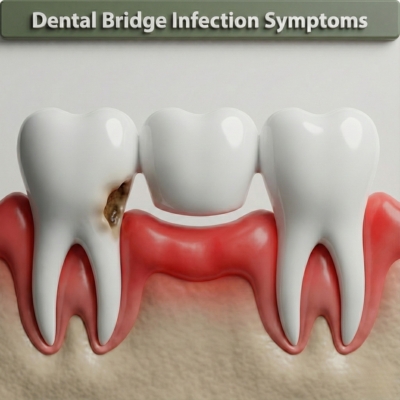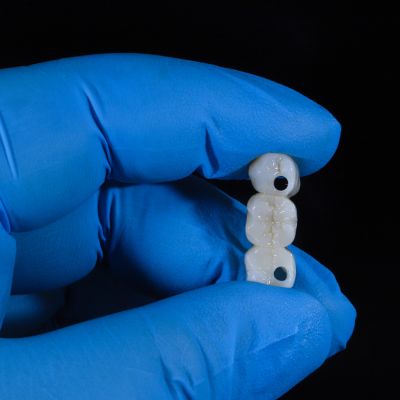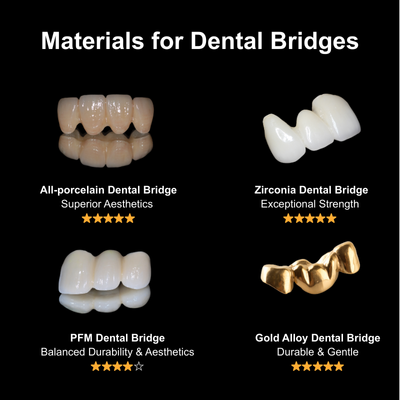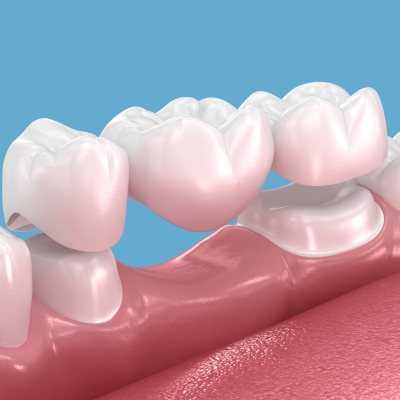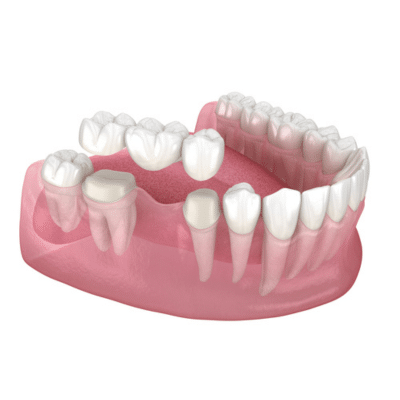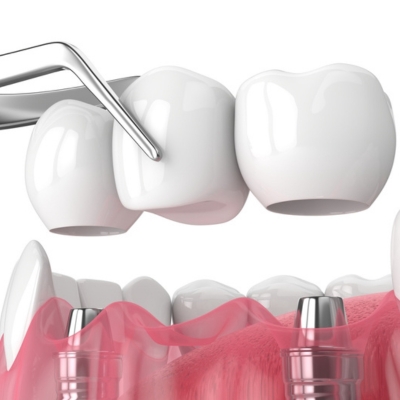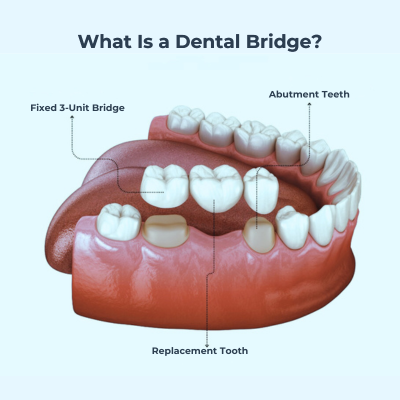News + Articles
6 Key Symptoms of an Ill-Fitting Dental Bridge and What to Do
An ill-fitting dental bridge cause pain, discomfort, and bite problems if not professionally addressed.
The most common signs of a poor fit include persistent pain when chewing, a loose sensation, visible gaps at the gum line, and an uneven bite.
This guide explains the six key symptoms of an ill-fitting dental bridge, explores the main causes, outlines immediate steps to take, and answers common questions to help you protect your oral health.
Symptom 1: Persistent Pain or Discomfort
Persistent pain, such as a dull ache or sharp pain when chewing, is the most direct sign of an ill-fitting bridge.
This discomfort is caused by uneven pressure from an improper fit, which overloads the supporting teeth, leading to micro-fractures, nerve inflammation, and even bone loss around the tooth root over time.
Symptom 2: A Loose or Unstable Feeling
A dental bridge must feel completely secure and stable in your mouth. Any sensation of looseness, shifting, or clicking sounds definitively indicates an incorrect fit.
This instability is caused by failed dental cement or underlying problems with the supporting abutment teeth.
A loose bridge creates a dangerous gap around the bridge margins, where harmful bacteria can seep between the crown and the natural tooth, creating an ideal environment for rapid decay in areas that cannot be cleaned with a toothbrush or floss.
Symptom 3: Difficulty Chewing and Biting
A correctly fitted dental bridge should feel completely natural in your bite, allowing you to chew evenly without a second thought.
If you notice your bite feels uneven, as if one tooth makes contact before the others, it is a definitive sign of misalignment.

This condition, known as malocclusion, disrupts the natural mechanics of your jaw. Over time, this imbalance can lead to 4 serious issues:
- Temporomandibular Joint (TMJ) disorders.
- Chronic jaw pain, tension headaches, and neck pain.
- Excessive or uneven wear on your opposing natural teeth.
- Chipped or fractured teeth due to incorrect bite forces.
Symptom 4: A Visible Gap at the Gum Line
A correctly fitted dental bridge sits flush against the gums, creating a seal that protects the underlying tissue.
Any noticeable gap between the base of the bridge and your gum line is a significant structural problem because it creates a trap for food particles and plaque.

This gap establishes a high-risk zone for two serious oral health problems: gum disease (gingivitis or periodontitis) and recurrent decay under the bridge, which can compromise the supporting teeth and lead to total bridge failure.
Symptom 5: Swollen, Bleeding, or Irritated Gums
Healthy gums surrounding a dental bridge should appear firm and pink. Consistently red, swollen, or bleeding gums are a clear symptom of chronic irritation.
This irritation is a direct result of two common issues: a bulky restoration that creates excessive pressure on the soft tissue, or a rough, poorly-contoured margin that traps plaque and bacteria.

If left unaddressed, this constant inflammation can cause the gums to recede from the supporting teeth.
This process exposes the sensitive tooth root and creates periodontal pockets, which can destabilize the bridge’s entire foundation and ultimately lead to its failure.
Note that while this starts as mechanical irritation, the trapped bacteria can eventually cause a severe infection if not adjusted.
Symptom 6: Damage to Supporting (Abutment) Teeth
The natural teeth that anchor the bridge, known as abutment teeth, are highly susceptible to damage from an improper fit.
Uneven pressure and torque from a poorly seated bridge can cause these crucial teeth to fracture, loosen, or develop decay underneath the crowns.
Damage to an abutment tooth is one of the most serious consequences of an ill-fitting bridge; because these teeth are the foundation, the failure of a supporting tooth means the entire restoration will fail with it.
These six symptoms are clear indicators of a problem. Understanding what causes a dental bridge to fit improperly is the first step toward finding a lasting solution.
What Causes a Dental Bridge to Fit Improperly
Understanding the cause of the problem is the first step toward finding a solution. There are three primary reasons why a dental bridge may fit poorly.
Errors During the Initial Fitting Process
The most common reason is an issue during its creation or placement. Inaccurate impressions, errors at the dental lab, or improper cementing can all result in a bridge that doesn’t fit from the start.
Natural Changes in Your Mouth Over Time
Your mouth changes over the years. The jawbone can shrink after tooth loss, or your remaining teeth may shift.
These changes can alter the bridge’s foundation, causing a once well-fitted bridge to become misaligned.
Damage or Wear to the Bridge or Supporting Teeth
A bridge and its supporting teeth can be damaged by trauma, teeth grinding (bruxism), or decay. If an abutment tooth is compromised or the bridge itself cracks, the fit will be affected.
What to Do If You Experience These Symptoms
If you recognize any of the seven symptoms, seeking immediate professional dental attention is essential. At Restoration Dental OC, our first step is a gentle, professional assessment to accurately diagnose the problem.
We use a combination of tactile examination, bite analysis, and digital X-rays to check the health of the bridge and its supporting teeth. Attempting to fix the bridge yourself can cause irreversible damage.
Based on our findings, we may recommend one of the following solutions:
Bridge Adjustment: For minor bite issues or discomfort, we can often carefully reshape the bridge in-office for a perfect fit.
Professional Re-cementing: For a bridge that is loose but structurally sound, professional re-cementing is often the simplest solution. The process for how a bridge can be safely removed and re-cemented is gentle and can often be completed in a single visit.
Bridge Repair or Replacement: When a bridge or supporting tooth is damaged, we’ll help you choose the best solution, either a strong, long-lasting repair or a new custom-made dental bridge that restores your smile naturally.
In cases where a supporting abutment tooth is lost, a more permanent and stable foundation is required. For this, a dental implant may be the ideal alternative for a new restoration.
How to Ensure a Long-Lasting, Comfortable Bridge Fit
Proper dental care is essential for extending the life of your dental bridge. An ill-fitting bridge can place stress on the supporting teeth, shortening its typical lifespan from 10 to15 years to as little as 5 to7 years.
For a deeper understanding of the key factors that determine bridge longevity, such as materials, bite alignment, and daily care habits, see our guide on how long a properly fitted dental bridge can last under ideal conditions.
The Importance of Excellent Oral Hygiene
Maintaining a rigorous oral hygiene routine is critical. Plaque can accumulate around and under the bridge, leading to decay and gum disease.
Be sure to brush thoroughly and use special tools like floss threaders, interproximal brushes, or water flossers to clean beneath the artificial teeth.
Why Regular Dental Check-ups Are Crucial
During regular check-ups, your dentist can professionally clean the bridge, check its stability, and identify potential issues before they become severe.
Frequently Asked Questions
Why does my new dental bridge feel too big or bulky?
It is common for a new bridge to feel slightly different for the first few days. However, if this feeling persists for more than a week or interferes with your bite, it definitively requires a professional adjustment by your dentist.
Is it normal for a new dental bridge to cause pain when chewing?
No, sharp pain when chewing with a new bridge is not normal. While mild adaptation sensitivity for up to 72 hours is common, sharp pain indicates an incorrect bite alignment that requires immediate attention.
How much of a gap between the bridge and the gum line is considered normal?
None. A well-designed dental bridge should sit flush against the gum tissue to create a seal that prevents food and bacteria from getting trapped underneath
Schedule Your Gentle Bridge Assessment Today
Don’t let discomfort from an ill-fitting bridge worsen. Contact Restoration Dental OC for a gentle, stress-free consultation. Our caring team will create a personalized plan to restore your confident, pain-free smile.
Protecting your dental restorations is a core part of our approach to gentle dentistry. Call us today or book your appointment online to find lasting relief.

Dr. Ronald Pham, DDS, is a Doctor of Dental Surgery who graduated from the USC Ostrow School of Dentistry in 2015. With over 8 years of experience in restorative dentistry, including dental implants, crowns, bridges, fillings, root canals…
Dr. Pham has restored the smiles of +2,000 patients and is committed to providing professional dental care focused on patient comfort. He achieves this by combining a welcoming space and state-of-the-art dental technology.
Book Your Appointment Now
Related Articles

Guaranteed Smiles!
As a premiere dentist office in Orange CA, we will always make sure that your experience is memorable, friendly, and professional. We strive to meet your highest expectations in every way imaginable, from your very first interaction with our office staff, to the quality of treatment you receive. We don’t take our patients’ trust for granted, and will promise to over-deliver with your best interest in mind. So give us a call today, and experience our first-class service!
Insurance
Accepted
We proudly accept most dental insurance plans, and welcome cash patients as well. Call us today for more information.
$199
Special
New to our dental office? Take advantage of our New Patient special offer with x-rays, exam, and full report of findings.
Extended
Hours
Do you have an emergency? Need to see us a little later or earlier? Let us know. We can be flexible to meet your busy schedule!

